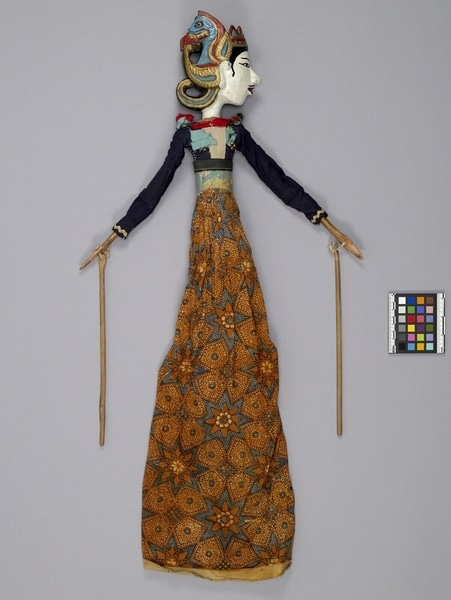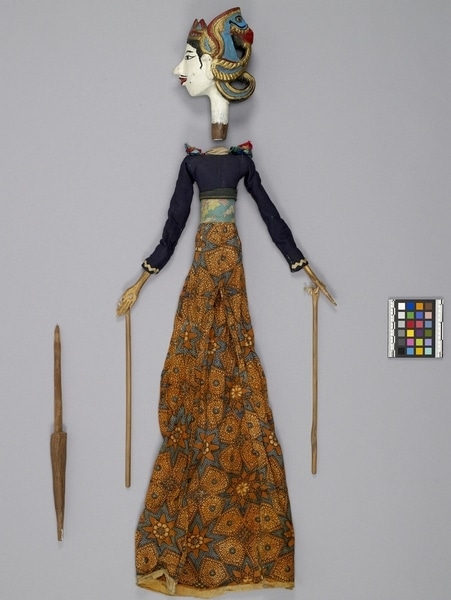Rod Puppet Item Number: Ib335 a-c from the MOA: University of British Columbia


Description
Three-dimensional male humanoid puppet: large head (part b) fits into body with skirt (part a), and a control rod (part c) with a long shaft that passes through the body and fits into the neck of the figure's head. The body has jointed arms, each with a long controlling rod attached. Head: forward gazing white face, black eyes, red lips, gold teeth, black moustache, sideburns and hair. Headdress: jamang-blue points outlined in red; gold, red and blue bands across bottom, blue and gold sumping. Garuda Mungkur mostly gold with blue and red trim, black line mouth, gold and red eye, red tongue. Clothing: dark blue tutupan, gold pattern on cuff, white breast piece, blue swatches over each breast held by three gold beads on right and two broken beads on left. Red cloth at throat, epaulettes in orange, red and blue. Two waistbands; top is green and black check with gold and black bands at bottom, lower waistband has floral design in blue, yellow, red and white. The figure is also wearing a light orange, off-white, dark orange and blue batik sarong. The hands are flat.
History Of Use
Javanese puppetry as an art form probably developed by the 11th century. The three-dimensional wooden wayang golek puppets of western Java appeared during the 16th century. Originally the plays depicted Javanese mythology, but after the Indian conquest of Java the Hindu epics, Ramayana and Mahabharata, were incorporated into the cycles, which comprise about 200 plays. An individual or group hires a dalang (puppet-master) to celebrate important occasions. The performances often last all night and are generally presented in three acts, with vocal and instrumental accompaniment. The individual plays vary widely in detail but usually involve conflict between good and evil. They serve a moral and religious purpose, and more recently, one of political commentary. Each puppet's character is represented by its appearance and placement onstage; protagonists with strong elements of good are placed to the right, antagonists of violent or evil nature to the left. Citrasena is a member of the Kurawas, the antagonists of the Pandawa cycle of plays derived from the Mahabharata epic. They are in conflict with the good Pandawa brothers in a property dispute which gains the attention of the gods and the involvement of the evil ogres and demons. As Citrasena has qualities of both good and evil but is still a Kurawa demonstrates how the conflict can be at times ambiguous.
Cultural Context
Theatrical performance.
Iconographic Meaning
White, forward gazing face with a moustache combined with a tutupan, batik skirt and a Garuda headdress the character in the nobility. He is an advisor, Citrasena, a Kurawa with a relatively friendly personality.
Item History
- Made in Java, Indonesia
- Owned by Tradewind Antiques before March 15, 1983
- Received from Museum of Anthropology Shop Volunteers (Funding source) and Tradewind Antiques (Seller) on March 15, 1983
What
- Name
- Rod Puppet
- Identification Number
- Ib335 a-c
- Type of Item
- puppet
- Material
- wood, cotton fibre, paint, fibre and glass
- Manufacturing Technique
- carved, painted, machine woven, sewn and knotted
- Part A
- height 64.5 cm, width 11.5 cm, depth 4.5 cm
- Part B
- height 18.0 cm, width 8.0 cm, depth 11.8 cm
- Part C
- height 30.5 cm, diameter 2.3 cm
Who
- Culture
- Sundanese
- Previous Owner
- Tradewind Antiques
- Received from
- Museum of Anthropology Shop Volunteers (Funding source) and Tradewind Antiques (Seller)
Where
- Holding Institution
- MOA: University of British Columbia
- Made in
- Java, Indonesia
When
- Ownership Date
- before March 15, 1983
- Acquisition Date
- on March 15, 1983
Other
- Condition
- fair
- Accession Number
- 0886/0069 a-c